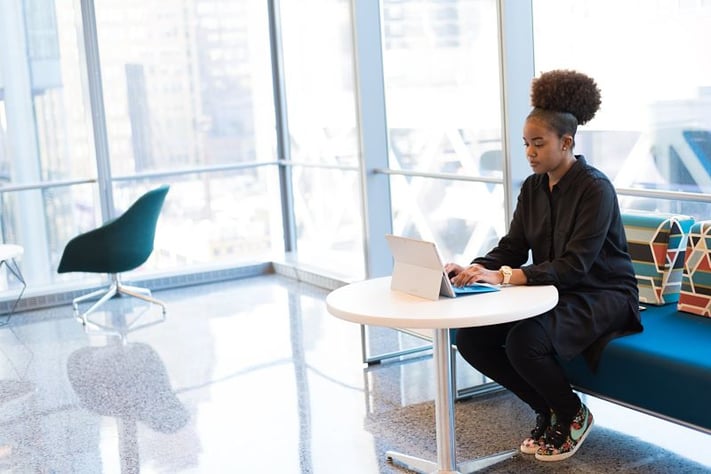
It’s time to plan the look of the employee break room.
There is much to consider and, while you’re feeling some excitement about it, you also have some hesitation, simply because there’s so much to consider. Where is the best place to begin?
For starters, an employee break room must be functional, practical, durable, and easy to clean. But that doesn’t mean it has to look and feel institutional. In fact, it’s preferable for the space to be comfortable and inviting, remembering that employees use it to take a much-earned break.Three simple things you can do to immediately infuse comfort into the break room are to add live plants (make sure someone is assigned to care for them); hang some art, as opposed to signs about your mission statement and short- and long-range goals (save those for the lobby); and stock the cupboard with recyclable paper goods, and all natural cleaning and dish detergents.
Beyond that, here’s a step-by-step guide to the major elements contained within an employee break room and what needs to be considered for each.
Walls
When it comes to walls, there are two things to consider: color and the paint itself. Regarding color, if you want to keep things simple, you can’t go wrong. Opt for white or light yellow because they coordinate with everything. White is energy producing, making an ideal environment for early morning or mid-afternoon meetings. Whites, light yellows, and other light colors reflect ambient light, brightening a space (especially a break room that may be small and/or have little natural light), and creating an airy and inviting atmosphere without invoking an institutional feel.
If you’re thinking neutral, but not sure beyond that, consider that any color can be neutral, and that it doesn’t have to be bland.
Cool Neutrals:
- Green
- Blue
- Violet
Warm Neutrals:
- Yellow
- Orange
- Red
A wall color bonus is that the space can be quickly and inexpensively refreshed every couple of years with a new coat of paint.
Regarding the paint itself, the main consideration is what finish option will help you achieve the look you desire.
There are three finish options.
- Flat (or matte) produces a saturated, velvety wall.
- Low-luster (eggshell and satin) has a matte look from straight on but, when viewed at an angle, has a little sheen, which makes it last longer. However, that sheen also shows the wall’s imperfections.
- Gloss (or semigloss) reflects light, holds up well in humidity, and is easy to clean. However, the fact that it reflects light means that it also shows the wall’s imperfections.
It used to be that, for durability and washability, you had to choose low-luster or gloss, and forego flat’s velvety richness. But not anymore. Paint manufacturers now offer durable, flat paints that are easy to clean.
Flooring
“Look at darker colors and patterns—even fun patterns—in your flooring,” says Dayton, Ohio-based independent interior designer Becca Robbins1. “They’re going to camouflage a lot of spills and stains.” She also recommends choosing a luxury sheet vinyl product because it offers high-traffic durability. “It’s a soft material that absorbs sound and may prevent breakage when dishes are accidentally dropped.” This is as compared to ceramic tile, of which sound bounces off rather than being absorbed and dropped dishes are guaranteed to break. Finally, she notes that sheet vinyl is available at a good price point, is easy to install, and easy to clean with a nonabrasive cleaner.
Lighting
Natural is the best lighting. However, it’s rarely enough, and gray days are to be expected, so supplemental lighting is a must. Also, sometimes employee break rooms are unavoidably situated on a building’s interior, away from natural light, so artificial lighting must be planned and installed. There are two considerations. The first is the fixture, and the second is the lamp.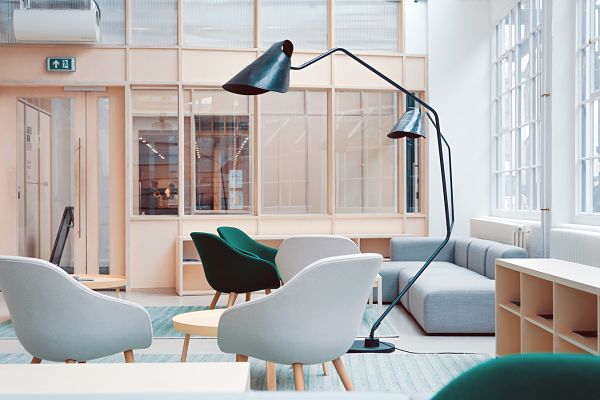
“I like to mix a lot of different types of lighting,” says Robbins, “to create a homey ambiance.” She recommends recessed lighting overall to ensure the break room is well lit, especially the countertop where food is prepared. Next, she chooses pendant lighting over dining tables. “It feels like a mini chandelier, so it’s casual but welcoming,” she says. Finally, in the lounge area, she prefers ambient light in the form of accent tables or floor lamps that have some texture for warmth: “It makes the space feel more like a house than an office.” For added touches, she suggests putting all the lighting on dimmer switches and adding undercabinet lighting, as softening the lighting creates a relaxing environment.
“When it comes to lighting,” says Robbins, “a huge factor, probably the most important factor, is the lamps (light bulbs) that you choose. Right now, LED (Light-Emitting Diode) lamps are popular because they’re energy efficient. When they first came out, they were harsh, and the light was bright, but they’re being improved upon all the time. Still, compare LEDs to incandescent lamps, which give a warmer, softer light.” That’s one more reason that she likes to mix the lighting and one more reason for using a dimmer if you use LED lamps in recessed fixtures.
Lounge area
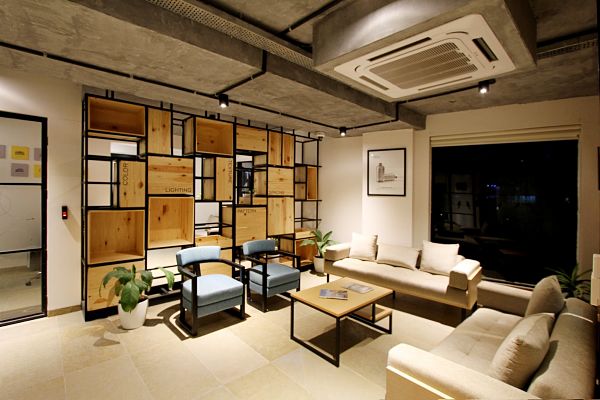
If the employee break room is large enough that you want to include a sofa and/or side chairs, there are several things to take into consideration.
Seating: “In design,” says Robbins, “there are universal sizes, which are units of measure used to design furniture for both short and tall people. It’s a way to meet in the middle when people of many different sizes are going to be using a space. So finding a universal fit is one of my top priorities.”
In terms of upholstery for that furniture, Robbins looks for performance fabrics. Association of Contract Textiles (ACT) defines performance by five characteristics:
- Flammability (a measurement of a fabric’s performance when exposed to specific sources of ignition),
- Colorfastness (a material’s degree of resistance to the fading effect of light),
- Wet and dry crocking (the transfer of dye from the surface of a dyed or printed fabric onto another surface by rubbing),
- Physical properties (key factors in assessing overall durability of fabric vary depending on the fabric construction), and
- Abrasion (the surface wear of a fabric caused by rubbing and contact with another fabric).1
Robbins also recommends asking about bleach cleanability, stain resistance, moisture resistance, and microbial resistance, as different brands of performance fabrics will offer varying degrees of these features. Rest assured that performance upholstery is available in a broad range of colors and patterns that are soft to the touch, so you’ll easily find the colors and patterns you have in mind for your employee break room.
Accent furniture: The sofas and chairs you choose for the employee break room lounge area need accent furniture, such as side tables and coffee tables. Robbins notes that durability is as important a feature here as it is upholstered pieces. When possible, she opts for the same materials she recommends for dining furniture: Formica, stone, or wood tops, or composites and plastics. When it comes to wood, there are numerous finishes available that serve to protect it. One that she especially likes is nitrocellulose lacquer, which produces a lovely shine to create a barrier between the wood and moisture. For more information about different types of lacquer, check out this blog post from The Wood Whisperer website, Different Types of Lacquer.
Dining tables and chairs:Durability is a must for dining tables and chairs because they’re going to experience a lot of use and you want your investment to both last and look nice for a long time. For tables, Robbins recommends Formica, stone, or wood tops because they are readily cleanable and withstand spills. “Even composites and plastics are available in stylish options for dining pieces,” she observes.
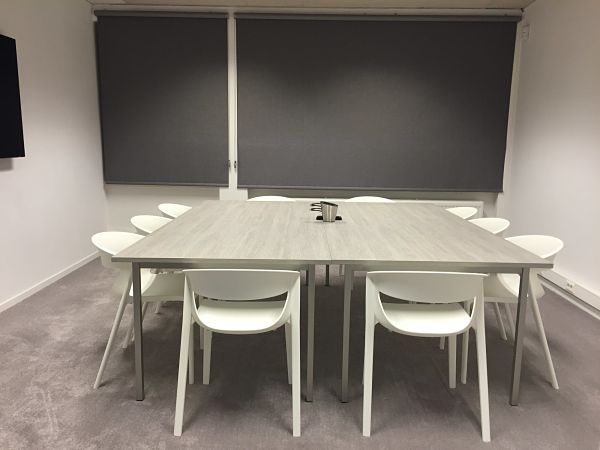
Composites and plastics are a go-to option if the furniture is frequently moved or rearranged, because they’re lighter weight than stone- or wood-topped tables. In addition, they are easily and quickly wiped down with a nonabrasive detergent. Robbins suggests composite or plastic chairs because of their cleanability. In the same vein, she recommends avoiding upholstered dining chairs, simply because they are more challenging to keep clean, even when a performance fabric is chosen. “You get what you pay for,” she reminds us, “so I prefer a commercial source as opposed to a residential source. A commercial source has done the research on the materials and has the usage information to back up the research. This is especially important in an employee break room, because not everyone does a thorough job of cleaning up after themselves.”
Kitchen area
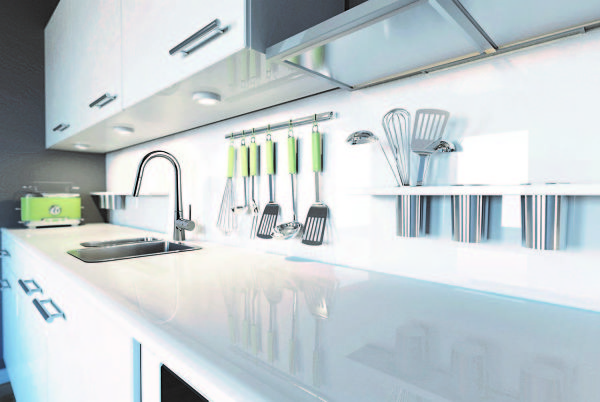
There are several elements that need careful consideration in an employee break room kitchen area.
Appliances: A refrigerator and microwave are must-have appliances. Do opt for high-quality because, again, you get what you pay for, so you may as well choose products that are known to have a long life and require little maintenance and repair. Make a list of your priorities (such as energy efficient, lifetime warranty, quiet, and sized to hold a pizza box), and request guidance from your architect/designer. Also consider looking at Consumer Reports’ Ratings & Buying Guides.
Cabinetry: With numerous openings and closings every day, cabinet doors and drawers take a beating. To ensure they withstand the test of time, choose cabinets with a smooth wood finish (choose from practically endless paint, stain, or glaze colors), solid frames, closed backs, solid door and drawer fronts, and reinforced corners. Avoid open cabinetry, which will rapidly show clutter as staff fill shelves with coffee mugs, leftover takeout napkins and condiments, vases, and forgotten Tupperware and Rubbermaid containers.
Countertops: Countertops come in a range of materials, some of which can be easily ruled out because of their high cost or high maintenance, such as marble, stainless steel, and granite. For durability, Robbins likes laminates, such as Formica and Wilsonart, because they’re affordable, easy to clean, easy to maintain, and available in thousands of colors, patterns, and styles. A laminate countertop is a plastic-coated synthetic material bonded to a particleboard (MDF) core that can be purchased as pre-formed segments or custom fabricated to your specifications.
“If you’re not on a tight budget,” Robbins offers, “quartz is the best choice for durability.” Quartz is an easy-to-maintain engineered stone containing quartz particles and other minerals that are shaped into slabs and bound with resins. It was created as an adaptable and better-performing alternative to marble and granite, and it looks the part. Its nonporous surface resists scratching and staining, requires no sealing, and is available in a wide range of colors.
Backsplash: Can you do without a backsplash? As a cost-saving measure, you absolutely can. However, you may want to install this easy-to-clean surface for two reasons. The first is so it serves its purpose: protecting the wall behind the sink from damage caused by water, other liquid, and food splashes. This high-use part of the room will look appealing for a far longer amount of time than if it will without a backsplash. The second is that it’s a way to infuse aesthetics into the space. Ceramic and glass tiles are common material types that will serve you well because they’re available in a variety of colors, shapes, and sizes, as well as a range of prices. Metal tiles and panels are another option, although they tend to create a more institutional feel.
Sink: Sinks come in four styles (top-mount, under-mount, apron-front, and tile-in). Tile isn’t a recommended countertop material because sound bounces off it, so this article addresses the first three sinks styles. Top-mount sinks, in which the sink rim extends above the countertop surface, are easy to install and work well with laminate countertops. Under-mount sinks, as the name implies, mount beneath the countertop, allowing you to easily brush food off the countertop into the bowl. They work well with quartz countertops. Apron-front sinks (also known as farmhouse sinks) are recognizable by their front panel (or apron). With apron-front sinks, you can choose from under-mount, top-mount, and tile-in models, as well as from enameled cast iron and stainless steel.
Faucet: The right faucet can make or break the functionality of the sink/faucet pairing. Because you’re making thoughtful design decisions in the first place, you’ll want to give this careful attention, as there’s much to consider. For example, you can choose from one-handle, two-handle, or touch-free faucets. You can choose from pull-down, pull-out, or side spray faucets. You can choose from deck- or wall-mounted faucets. There are high arcs (eight to 10 inches above the plane) and low arcs (three to eight inches above the sink plane). A word of caution: The faucet decision must be made before ordering the sink, so that you know how many holes the sink should have. To top off all these options, there are numerous finishes from which to choose.
Overall, you can’t go wrong with Chicago Faucets’ High Arc Pull-down Spray single-handle, heavy-duty faucet. The pull-down design and swivel spout work together to provide extra reach with a wide range of motion. Easy push-button convenience allows the user to easily switch water flow between fill and spray. It’s design and ease make it a versatile addition to any employee break room.
There are additional sink features to consider—simple touches that will garner much appreciation because of their employee friendliness. One is an instant hot water dispenser, which, as its name implies, dispenses nearly boiling water instantly for quick cups of tea, bowls of oatmeal, and ramen noodles.
Another feature is a filler station for water bottles and glasses. This added convenience allows employees to simply press a glass or water bottle against the lever, and water is dispensed in a one-handed operation. Chicago Faucets offers two different glass fillers—312-ABCP and 712-ABCP.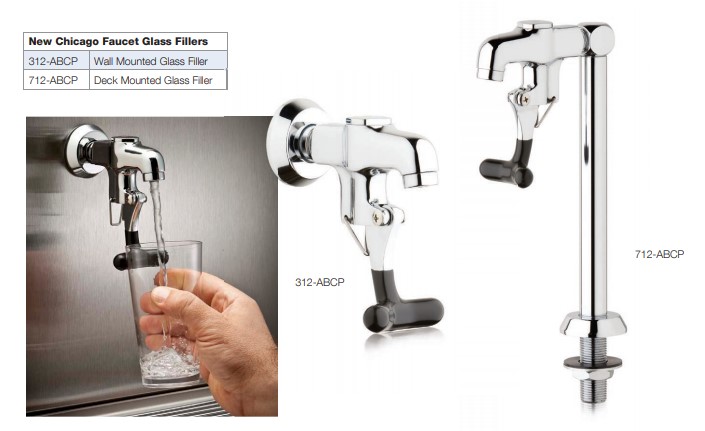
Both models are available in single-hole, deck- or wall-mount options with chrome-plated, solid brass bodies and heavy-duty metal levers with rubberized coatings to protect glassware. All-brass piston valves with easy access simplify maintenance, and flow volume adjustment allows you to fine tune water flow based on the building’s water pressure. Finally, they’re easy to install, and all mounting hardware is included.
Careful consideration of each of the above-mentioned elements, along with seeking the wisdom and guidance of an architect/designer, will ensure that your employee break room is functional, practical, durable, and easy to clean, as well as inviting, for which your employees will be appreciative as they seek a place to rest and refuel during the day.
Resources
- Becca Robbins Interior Design. Visit and contact her at https://www.houzz.com/pro/r3designs1/becca-robbins-interior-design?fbclid=IwAR25KVfCVf6DVMmrF42WS_cdNqHrlfzmB8HqwzeA39gZK8B22w9IrfulR3g
- ACT Voluntary Performance Guidelines. (January 2015). Retrieved May 12, 2019, from http://contracttextiles.org/wp-content/uploads/2016/09/act_perf_guidelines_overview_011615.pdf
- Different Types of Lacquer. (June 2, 2008). Retrieved May 12, 2019, from https://www.thewoodwhisperer.com/articles/different-types-of-lacquer/
- Ratings & Buying Guides. (n.d.). Retrieved May 12, 2019, from https://www.consumerreports.org/appliances/
.png)


